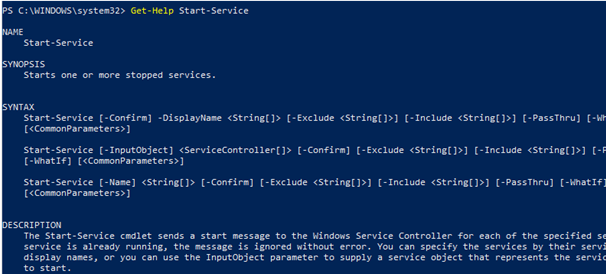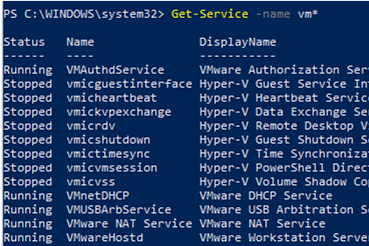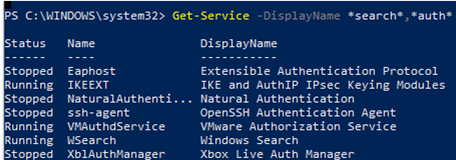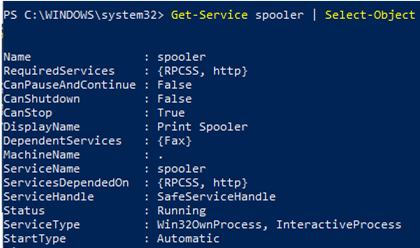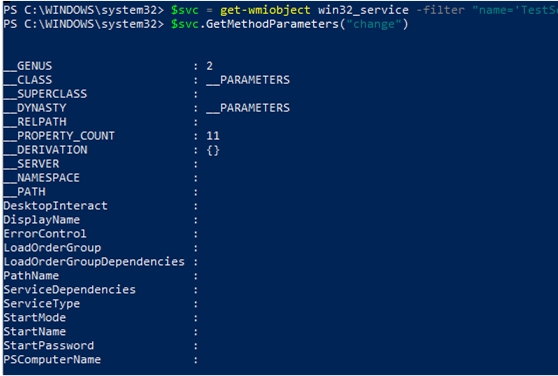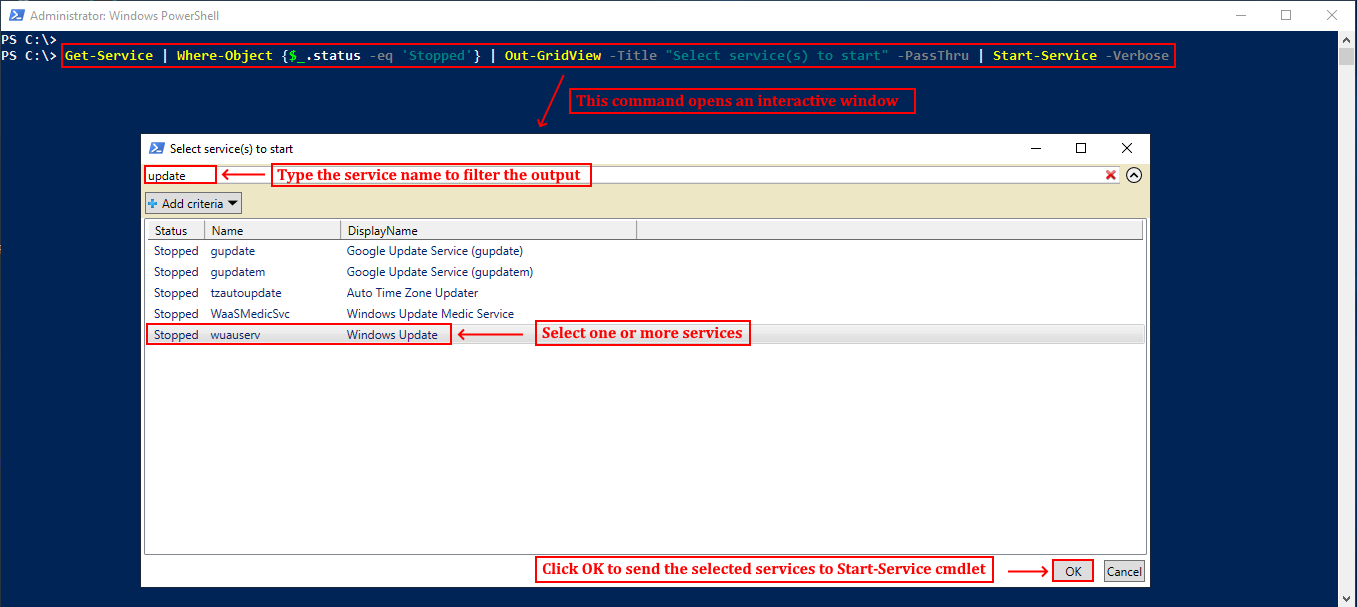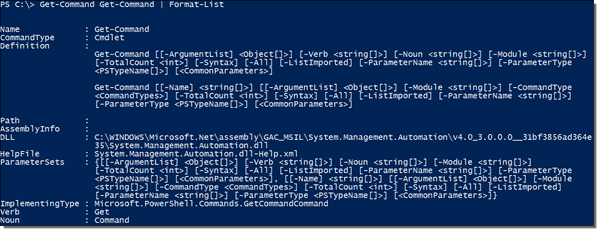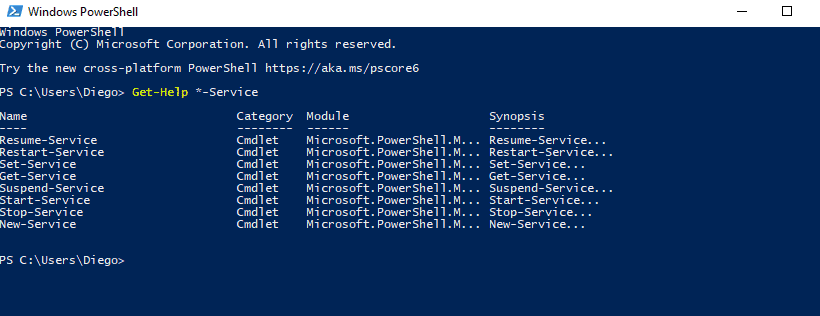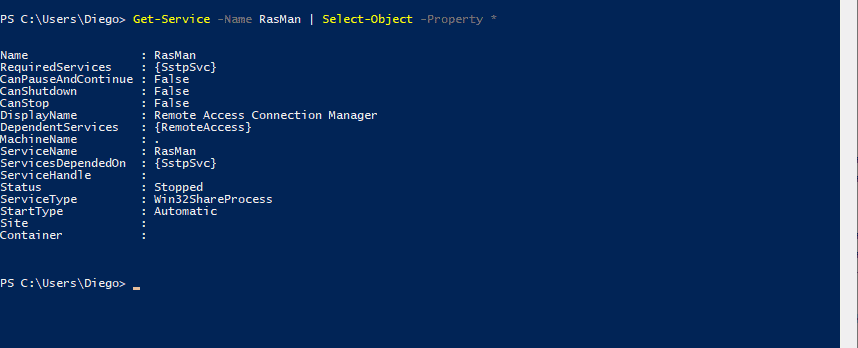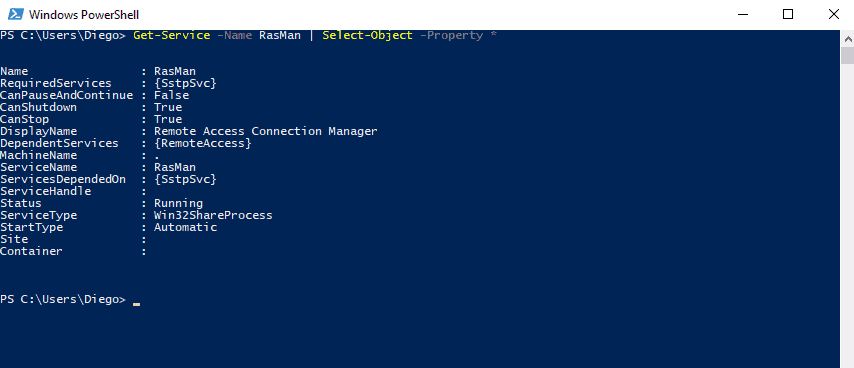You can manage Windows services not only from the services.msc snap-in or sc.exe command line tool, but also using PowerShell. In this article we’ll consider different scenarios of managing Windows services with PowerShell.
Contents:
- PowerShell Cmdlets Used to Manage Windows Services
- How to Check Windows Service Status with Get-Service?
- How to Stop, Start, or Restart Service with PowerShell?
- Using Set-Service to Change Service Settings
- How to Create or Delete a Windows Service via PowerShell?
- Change the User Account that Runs the Windows Service
PowerShell Cmdlets Used to Manage Windows Services
There are eight basic Service cmdlets to view the state of Windows services and manage them. To get the full list of service management cmdlets, run this command:
Get-Help *-Service
- Get-Service — allows to get the services on a local or remote computer both in running or stopped state;
- New-Service – creates a service. The cmdlet creates a new entry for a Windows service in the registry and in the service database;
- Restart-Service – restarts a service. The cmdlet sends the restart message through the Windows Service Controller;
- Resume-Service – resumes a service. The cmdlet sends a resume message to Windows Service Manager;
- Set-Service — changes the settings of a local or remote service, including its state, description, displayed name or startup mode. You can also use this cmdlet to start, stop or suspend a service;
- Start-Service – starts a service;
- Stop-Service – stops a service (the cmdlet sends a stopping message to Windows Service Manager);
- Suspend-Service – suspends a service. A suspended service is still running, but it does not do anything till it is resumed using( for example, with the Resume-Service cmdlet).
You can get a detailed description and examples of using a particular cmdlet with Get-Help:
Get-Help Start-Service
How to Check Windows Service Status with Get-Service?
You can get the list of services and their state (Running/Stopped) on a local or remote computer using the Get-Service cmdlet. The –Name parameter allows to select services by name. The service name can be specified using the wildcard character *.
If you do not know the exact service name, you can find it by its displayed name using the –DisplayName parameter. You can use the list of values and wildcards.
Use the Get-Service cmdlet with the -ComputerName parameter to get the service status on a remote computer. You can query the service status on multiple remote computers at once by specifying their names separated by commas. For example, the command shown below gets the Spooler service status on the remote computers ny-prnt1 and ny-prnt2.
Get-Service spooler –ComputerName ny-prnt1,ny-prnt2
Status Name DisplayName ------ ---- ----------- Running spooler Print Spooler Stopped spooler Print Spooler
To display all the properties of a service, use the Select-Object cmdlet:
Get-Service spooler | Select-Object *
The Select-Object cmdlet allows to get specific properties of a service. For example, you want to view the name, status and available options of the Spooler service:
Get-Service Spooler | Select DisplayName,Status,ServiceName,Can*

The Get-Service cmdlet has two parameters that allow you to view the service dependencies:
- -DependentServices allows to display the services dependent on the given service
- -RequiredServices displays the services the given service depends on
The following command displays the services required to start the Spooler service:
Get-Service –Name Spooler -RequiredServices
The following command shows the services that depend on Spooler:
Get-Service –Name Spooler -DependentServices

If you want to find the services with the specific state or parameters, use the Where-Object cmdlet. For example, let’s get the list of running services:
Get-Service | Where-Object {$_.status -eq 'running'}
To display the services with the manual startup type, run this command:
Get-Service | Where-Object {$_.starttype -eq 'Manual'}
Use the following PowerShell script to check if a specific Windows service exists on a current computer:
if (Get-Service "ServiceTest" -ErrorAction SilentlyContinue)
{
Write-host "ServiceTest exists"
}
How to Stop, Start, or Restart Service with PowerShell?
You can stop a service using the Stop-Service cmdlet. To stop the Spooler, run the command:
Stop-Service -Name spooler
The Stop-Service cmdlet does not display anything after execution. To see the result, use the -PassThru parameter.
Please note that not every service can be stopped. If there are any dependent services, you will see an error:
Cannot stop service because it has dependent services. It can only be stopped if force flag set.
To force a service to stop, use the –Force parameter. You should remember that all dependent services will also stop:
Stop-Service samss –Force -Passthru
The following command will stop the specified services (bits, spooler) if they are in “Running” state:
get-service bits,spooler | where {$_.status -eq 'running'} | stop-service –passthru
Sometimes services hang up in the “Stopping” state and have to be killed forcibly.
The Start-Service cmdlet starts a stopped service:
Start-Service -Name spooler -PassThru
A service won’t start, if any of its dependent services is stopped. To find and start them use the following PowerShell one-liner:
get-service samss | Foreach { start-service $_.name -passthru; start-service $_.DependentServices -passthru}
The Suspend-Servce cmdlet can pause services if they support this state. To learn if a service can be suspended, use the Get-Service cmdlet with the CanPauseAndContinue property.
Get-Service samss | Format-List name, canpauseandcontinue
To display the list of all services that may be paused, run this command:
Get-Service | Where-Object {$_.canpauseandcontinue -eq "True"}
Let’s suspend SQLBrowser service:
Suspend-Service -Name SQLBrowser
To resume a suspended service, use the Resume-Service cmdlet:
Resume-Service -Name SQLBrowser
The following command will resume all suspended services:
get-service | where-object {$_.Status -eq "Paused"} | resume-service
The Restart-Service cmdlet will restart a service:
Restart-Service -Name spooler
This command starts all stopped network services on a computer:
get-service net* | where-object {$_.Status -eq "Stopped"} | restart-service
These commands do not have the –ComputerName parameter, but you can run them on a remote computer using the Invoke-Command cmdlet or a pipe.
For example, to restart a print spooler on the remote computer ny-prnt1, run the command:
Get-Service Spooler -ComputerName ny-prnt1 | Start-Service
Using Set-Service to Change Service Settings
The Set-Service cmdlet allows you to change any parameters or settings of a service on a local or remote computer. Since the state of a service is a property, you can use this cmdlet to start, stop or suspend a service. Set-Service has the -StartupType parameter that allows to change the startup type of a service.
Let’s change the Spooler startup type to automatic:
Set-Service spooler –startuptype automatic –passthru
You can set the manual startup type:
Set-Service spooler –startuptype manual –passthru
How to Create or Delete a Windows Service via PowerShell?
New-Service – is a cmdlet to create a new service in Windows. Specify the name and the executable file for the new service (you can even run a PowerShell script as a Windows service).
Let’s create a new service with the name TestSvc:
new-service -name TestSvc -binaryPathName "C:WINDOWSSystem32svchost.exe -k netsvcs"
Get the information about the startup type and description of the service using the Get-WmiObject cmdlet.
get-wmiobject win32_service -filter "name='testservice'"
You can change the settings of the new service using the following command:
Set-Service -Name TestSvc -Description ‘My Service’ -StartupType Manual
To delete a service, run this command:
(Get-WmiObject win32_service -Filter ″name=′TestSvc′″).delete()
Change the User Account that Runs the Windows Service
You can use PowerShell in order to change user account used to start a service. Get the name of the account used to start TestSvc:
get-wmiobject win32_service -filter "name='TestSvc'" | Select name,startname
To change the username and password for a Windows Service, run the following commands:
$svc = get-wmiobject win32_service -filter "name='TestSvc'"
$svc.GetMethodParameters("change")
The list of the Change() method parameters is displayed. Count where the StartName and StartPassword parameters are: they located on the 20th and 21st places respectively.
$svc | Invoke-WmiMethod -Name Change –ArgumentList @ ($null,$null,$null,$null,$null,$null,$null, $null,$null,$null,$null,$null,$null,$null,$null,$null, $null,$null,$null,"Administrator","!123Pa$$w0rd")
Or you can enter the name of a gMSA account (the account password is not specified in this case).
As you can see, PowerShell makes it easy to manage Windows services. You can create, stop, start or resume services, and change their properties. Most cmdlets allow to manage services on remote computers.
Windows services is one of those topics nearly every Windows sysadmin has to work with. To manage Windows services you could fire up the services.msc MMC snap-in for one-off tasks but what if you need to build some kind of automation with PowerShell? Learn how to use PowerShell to get a service, use PowerShell start service cmdlet, use PowerShell to stop a service, and use PowerShell to restart a service in this tutorial!
It’s time to learn how to manage services with PowerShell.
In this tutorial, you’re going to learn all about the *-Service PowerShell cmdlets, how to use them and also build your own script to manage services on many computers at once.
Prerequisites
This article is going to be a walkthrough for you to hands-on learning about how PowerShell can read and manipulate Windows services. If you’d like to follow along, please be sure you have the following prerequisites in place before starting this article.
- At least one Windows computer. It’ll help if you have more than one to learn how to manage multiple computers at once.
- PowerShell 7 – Even though most of the concepts are the same as Windows PowerShell, you’re going to stick with the most recent version of PowerShell
- PowerShell Remoting enabled on any remote computer you’d like to query.
Using PowerShell to List Services with Get-Service
One of the most basic tasks you can accomplish with PowerShell and Windows services is simply enumerating what services exist on a local computer. For example, open up PowerShell and run Get-Service and observe the output.
Notice in the below screenshot running Get-Service by itself will list all services on the local computer and the Status, the Name and DisplayName of each service.

Like many other cmdlets, PowerShell though doesn’t return all of the properties for each service. If, for example, you’d like to see a service’s required services or perhaps the service description, you can find these properties by piping the output to Select-Object using * to represent all properties as shown in the following screenshot.
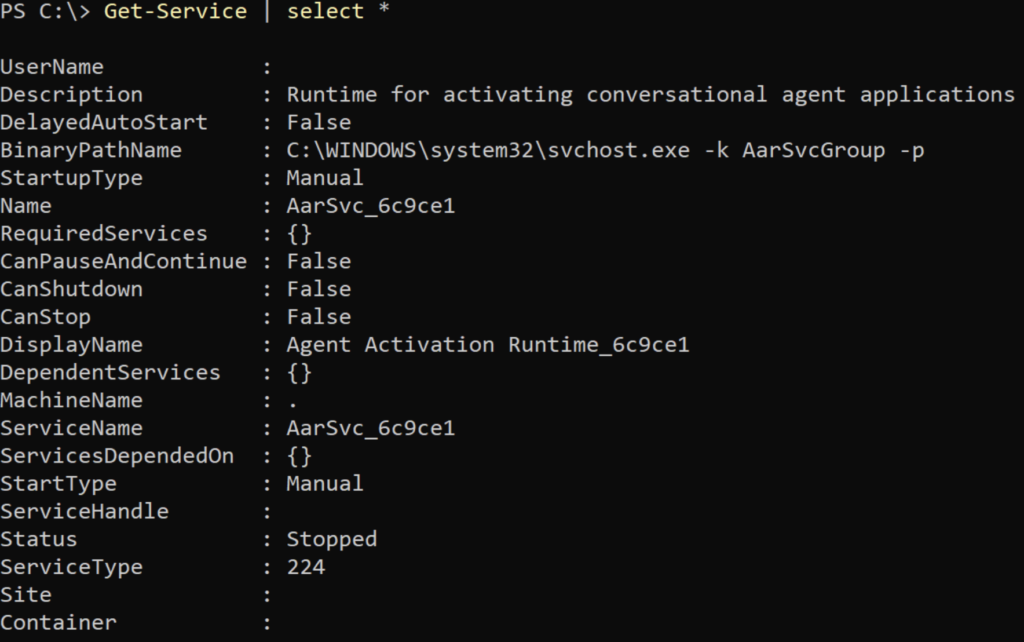
Finding Remote Services
Maybe you’re on a network and need to enumerate services across one or more remote Windows computers. In the Windows PowerShell days, this could have been done by using the ComputerName parameter but unfortunately that parameter doesn’t exist anymore.
With PowerShell Core though, finding remote services is still possible using two different methods; PowerShell Remoting CIM/WMI.
Get-Service and PowerShell Remoting
One way to inspect Windows services remotely is by using PowerShell Remoting (PS Remoting). By using PS Remoting, you can encapsulate any local command and invoke it in a remote session just as you were doing it locally.
Assuming you have PowerShell Remoting enabled on a remote computer, you could, for example, use Invoke-Command to run Get-Service on a remote computer like below.
Note that you don’t need the
Credentialparameter in an Active Directory (AD) environment.
$cred = Get-Credential
Invoke-Command -ComputerName SRV1 -ScriptBlock { Get-Service } -Credential $
Once executed, Invoke-Command passes on all of the information that Get-Service returned and services would be returned to you as expected.

Notice the extra PSComputerName property. This property is returned by Invoke-Command. You can also create a simple script to enumerate services across many remote computers too.
$cred = Get-Credential
$computers = Get-Content -Path 'C:computers.txt'
foreach ($name in $computers) {
$services = Invoke-Command -ComputerName $name -Credential $cred -ScriptBlock {Get-Service}
[pscustomobject]@{
ComputerName = $name
Services = $services
}
}Finding Services with CIM/WMI
In some situations, using PowerShell and Get-Service may not be suitable. Instead, you can query CIM/WMI via a CIM session. If using a CIM session, you don’t have to use PowerShell Remoting.
To find manage services via CIM, you can:
- Create a PSCredential object. In the below example, the two computers are not in an AD environment so we’re required to use the
Credentialparameter. - Create a CIM session providing the name of the computer and the credential to authenticate with.
- Use
Get-CimInstanceto make a query to the Win32_Service class.
$serverName = 'SRV1'
$cred = Get-Credential
$cimSession = New-CimSession -ComputerName $serverName -Credential $cred
Get-CimInstance -CimSession $cimSession -ClassName Win32_Service
## Don't forget to remove the CIM session when you're done
Remove-CimSession -CimSession $cimSessionYou’ll see below that much of the same information is returned but is formatted a bit differently.

PowerShell Start Service and Stop Service Cmdlet
You can also start and stop services with PowerShell. There are a couple of ways to make this happen.
Using PowerShell Start-Service and Stop-Service
First, you can use the Start-Service and Stop-Service cmdlets. These cmdlets do exactly what you’d expect. To use them, you can either use the pipeline or use the Name parameter as shown below.
## Stop a service with the Name parameter
$serviceName = 'wuauserv'
Stop-Service -Name $serviceName
## Stop a service with the pipeline
Get-Service $wuauserv | Stop-ServiceAll of the
*-Servicecmdlets allow you to tab-complete service name values with theNameandDisplayNameparameters. Just type-Namefollowed by a space and begin hitting the Tab key. You’ll see that it cycles through all of the services on the local computer.
The same concept applies to starting as service too.
## Stop a service with the Name parameter
$serviceName = 'wuauserv'
Start-Service -Name $serviceName
## Stop a service with the pipeline
Get-Service $wuauserv | Start-ServiceBoth the
Stop-ServiceandStart-Servicecmdlets are idempotent meaning if a service is either stopped or started and you attempt to stop or start the service when they are already in that state, the cmdlets will simply skip over the service.
To start and stop remote services with PowerShell, again, you’ll need to wrap these commands in a scriptblock and use PowerShell Remoting to invoke them remotely as shown below.
$cred = Get-Credential
$serviceName = 'wuauserv'
Invoke-Command -ComputerName SRV1 -ScriptBlock { Start-Service -Name $using:serviceName } -Credential $credLearn about the
$usingconstruct and how to pass local variables to remote scriptblocks in this Invoke-Command post.
Using PowerShell and CIM to Start/Stop Services
As with Get-Service, you can also use CIM to start and stop services. Although, you can’t directly use a cmdlet like Stop-Service and Start-Service. Instead, you have to invoke a method. Although a bit less intuitive, if you’re already managing some things with CIM, it might make sense to just manage service that way too.
If you’re working with local services, use Get-CimInstance again. This time though, you must limit the services down to only the services you’d like to stop or start using the Filter parameter. The Filter parameter (along with the Query parameter) is a great way to limit the results.
The below example is:
- Querying the local computer’s CIM store’s Win32_Service class for all services that have a startup type set to automatic (
StartMode='Auto') - Querying the local computer’s CIM store’s Win32_Service class for all services that also are stopped (
State='Stopped') - Passing all of those objects to
Invoke-CimMethodwhich then calls theStartServicemethod on each of them.
Get-CimInstance -ClassName Win32_Service -Filter "StartMode='Auto' And State='Stopped'" | Invoke-CimMethod -MethodName StartServiceThe same code above can also stop services too using the StopService method and perhaps changing the State in the query to Started.
The
Filterparameter accept a language known as WQL. You can learn more about WQL in PowerShell’s about_WQL help topic.
Starting/Stopping Remote Services with PowerShell
So you know how to start and stop services locally, you can also extend that to remote computers too using similar code used to enumerate services.
Note that you can always use PowerShell Remoting to wrap any code in a scriptblock and execute it remotely. This tutorial will assume from here on out you are aware of this potential and will not cover this option for all scenarios.
To start and stop services remotely, you can use a CIM session again. You could either reuse the CIM session you created above or if you removed it, create another one as shown below.
$serverName = 'SRV1'
$cred = Get-Credential
$cimSession = New-CimSession -ComputerName $serverName -Credential $credOnce you have created a CIM session, use the Invoke-CimMethod cmdlet and don’t forget to remove that CIM session when you’re done.
Get-CimInstance -CimSession $cimSession -ClassName Win32_Service -Filter "StartMode='Auto' And State='Stopped'" | Invoke-CimMethod -MethodName StartService
Remove-CimSession -CimSession $cimSessionYou don’t have to use a CIM session to manage remote Windows services. If both the local and remote computer are a member of an AD domain, you could use Get-CimInstance and the ComputerName parameter. However, if you must pass a credential to the remote computer, you must use a CIM session.
A CIM session also is a bit more efficient if you need to execute multiple CIM methods or perform CIM queries on the remote computer because it re-uses the same session instead of having to create a new one for each task.
Using PowerShell to Restart a Service
Maybe you want to restart a service that’s already started. That’s not a problem with PowerShell. Again, you’ve got two ways.
Using Start and Stop-Service
If you’d like to restart a started service, you could just stop and start the service with the Stop-Service and Start-Service cmdlets a few different ways as shown below.
## Restart a service with the Name parameter
$serviceName = 'wuauserv'
Stop-Service -Name $serviceName
Start-Service -Name $serviceName
## Restart a service with the pipeline and PassThru parameter
$serviceName = 'wuauserv'
Stop-Service -Name $serviceName -Passthru | Start-Service
If you need to pass the service object that
Stop-ServiceorStart-Servicejust ran on and you’d like to perform some other kind of action on that service via the pipeline, you can use thePassThruparameter. ThePassThruparameter simply tells the cmdlet to return the object to the pipeline which then allows you to pipe that object to other cmdlets.
Using the PowerShell Restart-Service cmdlet
To limit the code to restart a service with PowerShell, you’d be better off using the Restart-Service cmdlet. This cmdlet does exactly what you think and operates similarly to the othe service cmdlets.
For example, if you’d like to start the wuauserv as shown in the example above, you could save some code by just piping the output of Get-Service directly to Restart-Service as shown below.
## Restart a service with the Name parameter
$serviceName = 'wuauserv'
Get-Service -Name $serviceName | Restart-Service
Changing the Startup Type
Another popular task when managing services is changing the startup type. The startup type is the attribute that dictates what the services do when Windows boots up. You have a few options.
- Automatic (The service automatically starts when Windows does)
- Disabled (The service will never start)
- Manual (The service is available to start but must be done manually)
- Automate – Delayed (The service starts automatically but is delayed once Windows boots)
Let’s say you first just need to know what a service’s startup type is. You can find this with Get-Service or CIM.
If you’re using Get-Service to find the startup type, you’ll find that Get-Service calls it Status and is represented as the Status property.
(Get-Service -Name wuauserv).StartupType
Automatic
You can quickly get a glimpse on all of the services’ startuptype values by using Group-Object as you can see below. This screenshot shows all of the possible values (in the Name column) that a service’s startup type can be.

Once you know the current startup type, you can then change it using Set-Service.
The below example is setting the startup type to Disabled.
Set-Service -Name <some service name> -StartupType Disabled
Like the
NameandDisplayNameparameters, theStartupTypeparameter allows you to tab-complete all of the available startup types to set a service too.
Using the Registry
You can also set the service startup type via the registry via PowerShell. All Windows services are stored in the HKLMSystemCurrentControlSetServices registry key. Each service child key has a REG_DWORD value called Start that represents the startup type (excluding delayed start).
To set the startup type for a service in the registry via PowerShell, use the Set-ItemProperty cmdlet. The below snippet is changing the startup type of the wuauserv service to automatic.
$serviceName = 'wuauserv'
Set-ItemProperty "HKLM:SystemCurrentControlSetServices$serviceName" -Name "Start" -Value 2 -Type DWORD
You will need a map to define each REG_DWORD value to the startup type you expect. Below you’ll find a handy table.
| REG_DWORD Value | Startup Type |
| 0 | Loaded (but not started) by the boot loader. Then started during kernel initialization. |
| 1 | Started during kernel initialization after services whose start parameter is 0. |
| 2 | Automatically. Started by smss.exe (session manager) or services.exe (services controller). |
| 3 | Manually. Started by the Service Control Manager (SCM). |
| 4 | Disabled |
| 5 | Delayed start |
You may also set the startup type to delayed start by setting the DelayedAutoStart registry value to 1 via Set-ItemProperty -Path “HKLM:SystemCurrentControlSetServices<service name>” -Name “DelayedAutostart” -Value 1 -Type DWORD.
Next Steps
By now you should know the basics of restarting service with PowerShell along with managing them. If you’d like to learn more about managing services with PowerShell, be sure to check out PowerShell’s help content with Get-Help <cmdlet name>.
There are a lot of parameters not covered in this article so don’t fret if you didn’t see your particular use case here. Always refer to the help content and verify a parameter isn’t already there for you.
Further Reading
Provide the reader with at least two external links to other sites where the reader could find more information.
- Set Service Logon Account with PowerShell
- Back to Basics: The PowerShell ForEach Loop – This is great for managing services on many remote computers at once.
Manage Services using PowerShell
As a Windows administrator, you might need to deal with Services on regular basis. You mainly need to list the services, to stop them, and sometimes need to change the Startup Mode. PowerShell offers you various cmdlets which can help you deal with Services. But before start managing the Services, you need to run the PowerShell console with administrator privileges since PowerShell does not violate the Windows security policies; it respects the security policies.
To start, let’s first take a look at the PowerShell cmdlets with the noun “Service” in their name.
PS D:MyScripts> Get-Command -Noun Service CommandType Name ModuleName ----------- ---- ---------- Cmdlet Get-Service Microsoft.PowerShell.Management Cmdlet New-Service Microsoft.PowerShell.Management Cmdlet Restart-Service Microsoft.PowerShell.Management Cmdlet Resume-Service Microsoft.PowerShell.Management Cmdlet Set-Service Microsoft.PowerShell.Management Cmdlet Start-Service Microsoft.PowerShell.Management Cmdlet Stop-Service Microsoft.PowerShell.Management Cmdlet Suspend-Service Microsoft.PowerShell.Management
You can use the cmdlets shown above to work with Windows Services.
List all the Services on Your Computer
To list all the services on a computer you can use Get-Service cmdlet (or gsv alias) without any parameter.
PS D:MyScripts> Get-Service Status Name DisplayName ------ ---- ----------- Running AdobeARMservice Adobe Acrobat Update Service Stopped AeLookupSvc Application Experience Stopped ALG Application Layer Gateway Service Stopped AmmyyAdmin Ammyy Admin Stopped AmmyyAdmin_690 AmmyyAdmin_690 Stopped AppIDSvc Application Identity Running Appinfo Application Information Stopped AppMgmt Application Management Stopped AppReadiness App Readiness Stopped AppXSvc AppX Deployment Service (AppXSVC) Running AudioEndpointBu... Windows Audio Endpoint Builder Running Audiosrv Windows Audio Running AVP15.0.2 Kaspersky Small Office Security Ser... Stopped AxInstSV ActiveX Installer (AxInstSV) Stopped BDESVC BitLocker Drive Encryption Service Running BFE Base Filtering Engine [output cut]
Notice the default behavior of cmdlet is that it lists all the Services in a tabular format having three columns containing Status, Name and DisplayName of each service because Format-Table is the default formatting cmdlet used by Get-Service. This is pretty much satisfactory for most of administrators. But if you want to format the output in List form, you can do this by piping the output of Get-Service cmdlet to Format-List cmdlet (fl alias). The following example lists the services in list format.
PS D:MyScripts> gsv | fl Name : AdobeARMservice DisplayName : Adobe Acrobat Update Service Status : Running DependentServices : {} ServicesDependedOn : {} CanPauseAndContinue : False CanShutdown : False CanStop : True ServiceType : Win32OwnProcess Name : AeLookupSvc DisplayName : Application Experience Status : Stopped DependentServices : {} ServicesDependedOn : {} CanPauseAndContinue : False CanShutdown : False CanStop : False ServiceType : Win32ShareProcess Name : ALG DisplayName : Application Layer Gateway Service Status : Stopped DependentServices : {} ServicesDependedOn : {} CanPauseAndContinue : False CanShutdown : False CanStop : False ServiceType : Win32OwnProcess Name : AmmyyAdmin DisplayName : Ammyy Admin Status : Stopped DependentServices : {} ServicesDependedOn : {} CanPauseAndContinue : False CanShutdown : False CanStop : False ServiceType : Win32OwnProcess [output cut]
Notice that the output is now displayed in list format. In this format some additional properties are also listed for each service. This is default behavior of Format-List cmdlet. If you want to see specific properties, use -Property parameter followed by the property name in the same order you want to list. The following example with display the all services with 3 properties (Name, DisplayName, Status) in List format.
PS D:MyScripts> gsv | fl -Property Name, DisplayName, Status Name : AdobeARMservice DisplayName : Adobe Acrobat Update Service Status : Running Name : AeLookupSvc DisplayName : Application Experience Status : Stopped Name : ALG DisplayName : Application Layer Gateway Service Status : Stopped Name : AmmyyAdmin DisplayName : Ammyy Admin Status : Stopped
To display a specific service, use Get-Service cmdlet followed by the name of service. The following example displays the Windows Update service.
PS D:MyScripts> Get-Service "Windows Update" Status Name DisplayName ------ ---- ----------- Running wuauserv Windows Update
You can also use wildcard (*) to list multiple services starting or ending with same name. The following example lists all the services having microsoft keyword in their name.
PS D:MyScripts> Get-Service -DisplayName *microsoft* Status Name DisplayName ------ ---- ----------- Stopped MSiSCSI Microsoft iSCSI Initiator Service Stopped MsKeyboardFilter Microsoft Keyboard Filter Stopped odserv Microsoft Office Diagnostics Service Stopped smphost Microsoft Storage Spaces SMP Stopped swprv Microsoft Software Shadow Copy Prov... Stopped wlidsvc Microsoft Account Sign-in Assistant
Manipulate the Output of Get-Service
Remember that PowerShell provides a Get-Member cmdlet which helps you to list all the properties associated with any cmdlet. Taking advantage of Get-Service | Get-Member, we can refine the output so that we add extra properties, for example, CanStop and ServiceType.
PS D:MyScripts> Get-Service | Get-Member TypeName: System.ServiceProcess.ServiceController Name MemberType Definition ---- ---------- ---------- Name AliasProperty Name = ServiceName RequiredServices AliasProperty RequiredServices = ServicesDependedOn Disposed Event System.EventHandler Disposed(System.Object, System.EventArgs) Close Method void Close() Continue Method void Continue() CreateObjRef Method System.Runtime.Remoting.ObjRef CreateObjRef(type requestedType) Dispose Method void Dispose(), void IDisposable.Dispose() Equals Method bool Equals(System.Object obj) ExecuteCommand Method void ExecuteCommand(int command) GetHashCode Method int GetHashCode() GetLifetimeService Method System.Object GetLifetimeService() GetType Method type GetType() InitializeLifetimeService Method System.Object InitializeLifetimeService() Pause Method void Pause() Refresh Method void Refresh() Start Method void Start(), void Start(string[] args) Stop Method void Stop() WaitForStatus Method void WaitForStatus(System.ServiceProcess.ServiceControllerStatus desiredStatus), void Wa... CanPauseAndContinue Property bool CanPauseAndContinue {get;} CanShutdown Property bool CanShutdown {get;} CanStop Property bool CanStop {get;} Container Property System.ComponentModel.IContainer Container {get;} DependentServices Property System.ServiceProcess.ServiceController[] DependentServices {get;} DisplayName Property string DisplayName {get;set;} MachineName Property string MachineName {get;set;} ServiceHandle Property System.Runtime.InteropServices.SafeHandle ServiceHandle {get;} ServiceName Property string ServiceName {get;set;} ServicesDependedOn Property System.ServiceProcess.ServiceController[] ServicesDependedOn {get;} ServiceType Property System.ServiceProcess.ServiceType ServiceType {get;} Site Property System.ComponentModel.ISite Site {get;set;} Status Property System.ServiceProcess.ServiceControllerStatus Status {get;} ToString ScriptMethod System.Object ToString();
The following example illustrates how we can ‘Sort’ the output based on ServiceType rather than the ‘Name’ property.
PS D:MyScripts> Get-Service | Sort-Object -Property ServiceType | Format-Table Name, ServiceType, Status, CanStop -AutoSize Name ServiceType Status CanStop ---- ----------- ------ ------- Intel(R) ME Service Win32OwnProcess Running True Intel(R) PROSet Monitoring Service Win32OwnProcess Running True Intel(R) Capability Licensing Service TCP IP Interface Win32OwnProcess Stopped False RpcLocator Win32OwnProcess Stopped False Intel(R) Capability Licensing Service Interface Win32OwnProcess Running True LMS Win32OwnProcess Running True MozillaMaintenance Win32OwnProcess Stopped False TrustedInstaller Win32OwnProcess Stopped False jhi_service Win32OwnProcess Running True vds Win32OwnProcess Stopped False VSS Win32OwnProcess Stopped False FontCache3.0.0.0 Win32OwnProcess Running True wampapache64 Win32OwnProcess Stopped False Fax Win32OwnProcess Stopped False wampmysqld64 Win32OwnProcess Stopped False [output cut]
The -AutoSize parameter produces more sensible column widths.
Filtering the Output
If you are a System administrator, you might want to look at the services which are running and which have stopped. This can be done with the help of Where-Object cmdlet.
The following command will list the services which are stopped.
PS D:MyScripts> Get-Service | Where-Object {$_.Status -eq "Stopped"} Status Name DisplayName ------ ---- ----------- Stopped AeLookupSvc Application Experience Stopped ALG Application Layer Gateway Service Stopped AmmyyAdmin Ammyy Admin Stopped AmmyyAdmin_690 AmmyyAdmin_690 Stopped AppIDSvc Application Identity Stopped AppMgmt Application Management Stopped AppReadiness App Readiness Stopped AppXSvc AppX Deployment Service (AppXSVC) Stopped AxInstSV ActiveX Installer (AxInstSV) Stopped BDESVC BitLocker Drive Encryption Service Stopped BthHFSrv Bluetooth Handsfree Service Stopped bthserv Bluetooth Support Service Stopped COMSysApp COM+ System Application Stopped cphs Intel(R) Content Protection HECI Se... Stopped CscService Offline Files Stopped defragsvc Optimize drives Stopped DeviceInstall Device Install Service Stopped dot3svc Wired AutoConfig Stopped DsmSvc Device Setup Manager [output cut]
Take careful note of the syntax. The Where-Object is enclosed within curly braces. In addition, the $_ notation is used to represent the object being transferred across the pipeline. The .Status is calling the property of current service in pipeline. You can call any property which you have found using Get-Service | Get-Member command. Notice the comparison operator used is equal to (-eq). Windows PowerShell does not use the standard arithmetic comparison operators; instead, it uses operators such as:
- -lt — Less than
- -le — Less than or equal to
- -gt — Greater than
- -ge — Greater than or equal to
- -eq — Equal to
- -ne — Not equal to
- -like — Like; uses wildcards for pattern matching
- -match — Matches a string using regular expressions.
- -contains — Tells whether a collection of reference values includes a single test value. Always returns a Boolean value TRUE or FALSE.
- -replace — Changes the specified elements of a value.
If you want to look for the services which are Running, just replace the ‘Stopped’ keyword with Running in above command. The command is shown below:
PS D:MyScripts> Get-Service | Where-Object {$_.Status -eq "Running"} Status Name DisplayName ------ ---- ----------- Running AdobeARMservice Adobe Acrobat Update Service Running Appinfo Application Information Running AudioEndpointBu... Windows Audio Endpoint Builder Running Audiosrv Windows Audio Running AVP15.0.2 Kaspersky Small Office Security Ser... Running BFE Base Filtering Engine Running BITS Background Intelligent Transfer Ser... Running BrokerInfrastru... Background Tasks Infrastructure Ser... Running Browser Computer Browser [output cut]
You can also filter the output with Select-Object cmdlet using -Property parameter of command as shown below:
PS D:MyScripts> Get-Service | Select-Object -Property DisplayName, Status DisplayName Status ----------- ------ Adobe Acrobat Update Service Running Application Experience Running Application Layer Gateway Service Stopped Ammyy Admin Stopped [output cut]
The above commands will only display DisplayName and Status properties of windows services.
Use Get-Service on Remote Computer
You can use Get-Service cmdlet with –ComputerName parameter to retrieve and manipulate the services of remote computer as you did with local computer. You must have enough privileges on remote computer in order to run the command. Also note that Get-Service command does not use PowerShell remoting (WSMan) to retrieve data from remote computer; instead it uses dot net framework methods. So, you can run Get-Service cmdlet against any remote computer which does not have PowerShell remoting configured.
PS D:MyScripts> Get-Service -ComputerName DC1 Status Name DisplayName ------ ---- ----------- Running ADWS Active Directory Web Services Stopped AeLookupSvc Application Experience Stopped ALG Application Layer Gateway Service Running AppHostSvc Application Host Helper Service Stopped AppIDSvc Application Identity Running Appinfo Application Information Stopped AppMgmt Application Management Stopped aspnet_state ASP.NET State Service Stopped AudioEndpointBu... Windows Audio Endpoint Builder Stopped AudioSrv Windows Audio Running AVP15.0.2 Kaspersky Small Office Security Ser... Running BFE Base Filtering Engine Running BITS Background Intelligent Transfer Ser... [output cut]
Using Out-File cmdlet
You can use Out-File cmdlet to redirect and save the output of Get-Service and even the output of every cmdlet to a text file. This method can be helpful for logging.
PS D:MyScripts> Get-Service | Where-Object {$_.Status -eq "Stopped"} | out-file "D:Stopped_services.txt"
This time you will not see any output on console, instead the output is sent to file D:Stopped_services.txt file. If you look at the contents of file, the output would be similar to that of console output.
PS D:MyScripts> Get-Content D:Stopped_services.txt Status Name DisplayName ------ ---- ----------- Stopped AeLookupSvc Application Experience Stopped ALG Application Layer Gateway Service Stopped AmmyyAdmin Ammyy Admin Stopped AmmyyAdmin_690 AmmyyAdmin_690 Stopped AppIDSvc Application Identity Stopped AppMgmt Application Management Stopped AppReadiness App Readiness Stopped AppXSvc AppX Deployment Service (AppXSVC) Stopped AxInstSV ActiveX Installer (AxInstSV) Stopped BDESVC BitLocker Drive Encryption Service Stopped BthHFSrv Bluetooth Handsfree Service Stopped bthserv Bluetooth Support Service Stopped COMSysApp COM+ System Application Stopped cphs Intel(R) Content Protection HECI Se... Stopped CscService Offline Files Stopped defragsvc Optimize drives Stopped DeviceInstall Device Install Service [output cut]
Start a Windows Service
You can start any service with the help of Start-Service cmdlet. An example of starting a ‘Stopped’ windows update service is given below:
PS D:MyScripts> gsv wuauserv Status Name DisplayName ------ ---- ----------- Stopped wuauserv Windows Update PS D:MyScripts> Get-Service wuauserv | Start-Service -Verbose VERBOSE: Performing the operation "Start-Service" on target "Windows Update (wuauserv)".
In first command, I checked the status of Windows Update service. I saw it is stopped. So, I piped the output of Get-Service wuauserv command to Start-Service cmdlet and the service started. The -verbose switch displayed the information about the operation being performed.
PS D:MyScripts> Get-Service wuauserv Status Name DisplayName ------ ---- ----------- Running wuauserv Windows Update
You can also use the Start-Service cmdlet directly if you know the name of service you want to start. This is shown below:
PS D:MyScripts> Start-Service AmmyyAdmin -Verbose VERBOSE: Performing the operation "Start-Service" on target "Ammyy Admin (AmmyyAdmin)".
Stop a Windows Service
To stop any running service, use Stop-Service cmdlet as shown below:
PS D:MyScripts> Stop-Service AmmyyAdmin ; Get-Service AmmyyAdmin Status Name DisplayName ------ ---- ----------- Stopped AmmyyAdmin Ammyy Admin
This time I did not use -verbose switch, that’s why I did not see any information but the service is actually stopped. Notice that I’ve used semi-colon (;) to run two commands at one time. You can always run multiple PowerShell commands at once by using semi-colon (;) between each command.
Change the Service StartMode
Sometime you might want to see and even change the StartMode of any service. The StartMode is a condition which determines the behavior of service. The StartupMode can accept the following values:
- Automatic: The Service is started automatically as part of the Windows boot process.
- Manual: The Service can be started by any application, process or user whenever needed, but is off by default. Once it is started, the service will remain started until it is manually stopped or the system is rebooted.
- Disabled: The service is disabled. It will not run.
Unfortunately, Windows PowerShell does not have any built-in cmdlet which can display the StartMode for any service. The Get-Service cmdlet does not display StartMode property even when used with Format-List -Property * parameter.
PS D:MyScripts> Get-Service wuauserv | Select-Object -Property * Name : wuauserv RequiredServices : {rpcss} CanPauseAndContinue : False CanShutdown : False CanStop : False DisplayName : Windows Update DependentServices : {} MachineName : . ServiceName : wuauserv ServicesDependedOn : {rpcss} ServiceHandle : SafeServiceHandle Status : Stopped ServiceType : Win32ShareProcess Site : Container :
Look at the output of above command; you can not see the StartMode property. So, how do you come to know if any service (Windows Update for instance) is set to start automatically at system startup or it is set as manual?
Luckily, Windows PowerShell has a Get-WmiObject cmdlet which allows you to query WMI (Windows Management Instrumentation) on system and retrieve the data from WMI store. You can see the StartMode property of any windows service using Get-WmiObject cmdlet as shown below:
PS D:MyScripts> Get-WmiObject -Class Win32_Service ExitCode : 0 Name : AdobeARMservice ProcessId : 1532 StartMode : Auto State : Running Status : OK ExitCode : 0 Name : AeLookupSvc ProcessId : 0 StartMode : Manual State : Stopped Status : OK ExitCode : 1077 Name : ALG ProcessId : 0 StartMode : Manual State : Stopped Status : OK [output cut]
Notice that Get-WmiObject cmdlet by default uses Format-List to format the output and it displays all the information like that of Get-Service cmdlet including StartMode property. To display the output in the same format as Get-Service; use the following command:
PS D:MyScripts> Get-WmiObject -Class Win32_Service | Format-Table -Property State, Name, DisplayName, StartMode State Name DisplayName StartMode ----- ---- ----------- --------- Running AdobeARMservice Adobe Acrobat Update Service Auto Stopped AeLookupSvc Application Experience Manual Stopped ALG Application Layer Gateway Ser... Manual Stopped AmmyyAdmin_690 [output cut]
The above command produces the output similar to Get-Service cmdlet including StartMode property for every service.
To view the StartMode property for a particular service (Windows Update for instance), use the Get-WmiObject cmdlet as shown below:
PS D:MyScripts> Get-WmiObject -Class Win32_Service | Where-Object {$_.name -eq 'wuauserv'} | Format-Table -Property State, Name, Di splayName, StartMode State Name DisplayName StartMode ----- ---- ----------- --------- Running wuauserv Windows Update Manual
You see the above command became very lengthy. You can always shorten the commands by using aliases instead of typing complete command. The above command can be shortened as follows:
PS D:MyScripts> gwmi Win32_Service|?{$_.name -eq 'wuauserv'}|ft State,Name,DisplayName,StartMode
State Name DisplayName StartMode
----- ---- ----------- ---------
Stopped wuauserv Windows Update Manual
Now, we know that Windows update service has StartMode set to Manual. To change the StartMode, use Set-Service cmdlet with -StartupType parameter as shown below:
PS D:MyScripts> Set-Service wuauserv -StartupType Automatic -Status Running PS D:MyScripts> gwmi Win32_Service|?{$_.name -eq 'wuauserv'}|ft State,Name,DisplayName,StartMode State Name DisplayName StartMode ----- ---- ----------- --------- Running wuauserv Windows Update Auto
The -StartupType parameter can accept only 3 values (Automatic, Manual, Disabled) and the -Status parameter can also accept only 3 values (Running, Paused, Stopped).
Stop a Windows Service
You can stop a running windows service using Stop-Service cmdlet. Remember that there are some critical windows services which do not support stopping. To get the list of windows services which can be stopped, use the Get-Service cmdlet as shown below:
PS D:MyScripts> Get-Service | Where-Object {$_.Status -eq 'Running' -and $_.CanStop} Status Name DisplayName ------ ---- ----------- Running AdobeARMservice Adobe Acrobat Update Service Running Appinfo Application Information Running AudioEndpointBu... Windows Audio Endpoint Builder Running Audiosrv Windows Audio Running AVP15.0.2 Kaspersky Small Office Security Ser... Running BFE Base Filtering Engine Running BITS Background Intelligent Transfer Ser... Running Browser Computer Browser Running c2cautoupdatesvc Skype Click to Call Updater Running c2cpnrsvc Skype Click to Call PNR Service Running CertPropSvc Certificate Propagation Running CryptSvc Cryptographic Services [output cut]
To list all services that cannot be stopped, slightly modify the above command:
PS D:MyScripts> Get-Service | Where-Object {$_.status -eq 'running' -and !$_.CanStop}
Status Name DisplayName
------ ---- -----------
Running BrokerInfrastru... Background Tasks Infrastructure Ser...
Running DcomLaunch DCOM Server Process Launcher
Running LSM Local Session Manager
Running Power Power
Running RpcEptMapper RPC Endpoint Mapper
Running RpcSs Remote Procedure Call (RPC)
Running SamSs Security Accounts Manager
Running wudfsvc Windows Driver Foundation - User-mo...
Notice that I used Not Operator (!) in front of CanStop property. The same command could be written as follows:
PS D:MyScripts> Get-Service | Where-Object {$_.Status -eq 'Running' -and $_.CanStop -eq $false}
Status Name DisplayName
------ ---- -----------
Running BrokerInfrastru... Background Tasks Infrastructure Ser...
Running DcomLaunch DCOM Server Process Launcher
Running LSM Local Session Manager
Running Power Power
Running RpcEptMapper RPC Endpoint Mapper
Running RpcSs Remote Procedure Call (RPC)
Running SamSs Security Accounts Manager
Running wudfsvc Windows Driver Foundation - User-mo...
For example, to stop Windows Update service, run the following command:
PS D:MyScripts> Get-Service wuauserv | Stop-Service -Verbose VERBOSE: Performing the operation "Stop-Service" on target "Windows Update (wuauserv)". WARNING: Waiting for service 'Windows Update (wuauserv)' to stop... WARNING: Waiting for service 'Windows Update (wuauserv)' to stop...
The -verbose switch is used to display the information about the operation being performed. You could also use Stop-Service wuauserv command. Both will work and perform same thing.
Restart a Windows Service
PowerShell gives you Restart-Service cmdlet which works pretty much same way as that of Stop-Service and Start-Service cmdlets. The following example shows how to restart Windows Update service.
PS D:MyScripts> Restart-Service wuauserv -Verbose VERBOSE: Performing the operation "Restart-Service" on target "Windows Update (wuauserv)".
Pause and Resume Windows Service
The Suspend-Service cmdlet sends a suspend (pause) message to the Windows Service Controller for each of the specified services. While suspended, the service is still running, but its action is halted until resumed, such as by using Resume-Service. You can specify the services by their service names or display names, or you can use the InputObject parameter to pass a service object representing the services that you want to suspend.
The following command list all of the services on the computer that can be suspended.
PS D:MyScripts> Get-Service | Where-Object {$_.CanPauseAndContinue } Status Name DisplayName ------ ---- ----------- Running LanmanWorkstation Workstation Running Netlogon Netlogon Running stisvc Windows Image Acquisition (WIA) Running Winmgmt Windows Management Instrumentation
To Suspend (pause) the Workstation service on computer, use the following command.
PS D:MyScripts> Suspend-Service -DisplayName Workstation
Now the status service changed to Paused.
PS D:MyScripts> Get-Service Workstation Status Name DisplayName ------ ---- ----------- Paused LanmanWorkstation Workstation
To Resume the service, use Resume-Service cmdlet as shown below:
PS D:MyScripts> Resume-Service -DisplayName Workstation
Using Out-GridView cmdlet
PowerShell offers an Out-GridView cmdlet that sends the output to an interactive graphical table in a separate window. You can use Out-GridView along with Get-Service cmdlet to control services even more elegantly. See the following command as an example:
PS D:MyScripts> Get-Service | Where-Object {$_.status -eq 'Stopped'} | Out-GridView -Title "Select service(s) to start" –PassThru | Start-Service –Verbose
We are essentially getting the services that are currently stopped, passing them to Out-GridView cmdlet in a nice graphical table, where we can select one or more services (by pressing and holding Ctrl button). After making the selection, when we click OK, the selected services will then be passed to Start-Process cmdlet with the help of -PassThru parameter. Ultimately, the selected services will be started. You can use the same idea to stop running services.
Create a new Windows Service
The New-Service cmdlet creates a new entry for a Windows service in the registry and in the service database. A new service requires an executable file that executes during the service.
The parameters of this cmdlet let you set the display name, description, startup type, and dependencies of the service.
For example, I have downloaded a portable TFTP Server from internet and I want to create a new TFTP service on my computer. Use the following PowerShell command to create new service.
PS D:MyScripts> Get-Service | ? {$_.DisplayName -like "*tftp*"}
This command confirms if there is any existing service on computer with matching name.
The following command creates a new service with the name TFTPServer and sets the StartMode to Manual:
PS D:MyScripts> New-Service -Name TFTPServer -BinaryPathName "C:TFTPtftpd32.exe" -DisplayName "TFTP Server" -Description "Open Source TFTP Server" -StartupType Manual Status Name DisplayName ------ ---- ----------- Stopped TFTPServer TFTP Server
The newly created service is stopped. To start the service, use Start-Service cmdlet.
PS D:MyScripts> Start-Service TFTPServer -Verbose
Delete or Remove a Windows Service
Have you ever encountered in a situation when you have uninstalled any software but the it’s rellevant service keeps appearing in Windows Services? The service no longer work and you want to remove this service.However, Windows PowerShell does not give any Remove-Service cmdlet to use, but still you can use Get-WmiObject cmdlet to remove the service. Wodering how?
This is how you do it. Remember that you can create any variable in PowerShell using dollar ($) symbol. You need to create a $svc variable and store the service name into it. Then you need to call delete method and the service will be gone.
I will show you step by step process:
1). Create a $svc variable and store the service with the name TFTServer into it.
PS D:MyScripts> $svc = Get-WmiObject Win32_Service -Filter "Name='TFTPServer'"
2). To confirm, type the variable name ($svc) and press Enter.
PS D:MyScripts> $svc ExitCode : 0 Name : TFTPServer ProcessId : 0 StartMode : Manual State : Stopped Status : OK
3). Now you know that the service you want to remove is stored into $svc variable, use Get-Member cmdlet with -MemberType Method parameter to see the available methods for this service. The following command tells you what methods this service can accept.
PS D:MyScripts> Get-Member -InputObject $svc -MemberType Method TypeName: System.Management.ManagementObject#rootcimv2Win32_Service Name MemberType Definition ---- ---------- ---------- Change Method System.Management.ManagementBaseObject Change(System.String DisplayName, System.String PathName... ChangeStartMode Method System.Management.ManagementBaseObject ChangeStartMode(System.String StartMode) Delete Method System.Management.ManagementBaseObject Delete() GetSecurityDescriptor Method System.Management.ManagementBaseObject GetSecurityDescriptor() InterrogateService Method System.Management.ManagementBaseObject InterrogateService() PauseService Method System.Management.ManagementBaseObject PauseService() ResumeService Method System.Management.ManagementBaseObject ResumeService() [output cut]
4). We are only interested in delete method since we want to delete the service. Now, all you need to do is to call the delete method and the service will be removed. This is done with the following command.
PS D:MyScripts> $svc.delete()
__GENUS : 2
__CLASS : __PARAMETERS
__SUPERCLASS :
__DYNASTY : __PARAMETERS
__RELPATH :
__PROPERTY_COUNT : 1
__DERIVATION : {}
__SERVER :
__NAMESPACE :
__PATH :
ReturnValue : 0
PSComputerName :
5). Use the Get-Service cmdlet to confirm if the service is deleted or still exists.
PS D:MyScripts> Get-Service TFTPServer Get-Service : Cannot find any service with service name 'TFTPServer'. At line:1 char:1 + Get-Service TFTPServer + ~~~~~~~~~~~~~~~~~~~~~~ + CategoryInfo : ObjectNotFound: (TFTPServer:String) [Get-Service], ServiceCommandException + FullyQualifiedErrorId : NoServiceFoundForGivenName,Microsoft.PowerShell.Commands.GetServiceCommand
The above process is not so difficult. But if you believe in shorthand one-liners, below is a one-liner to delete a service:
PS D:MyScripts> (Get-WmiObject Win32_Service -Filter "Name='TFTPServer'").Delete()
__GENUS : 2
__CLASS : __PARAMETERS
__SUPERCLASS :
__DYNASTY : __PARAMETERS
__RELPATH :
__PROPERTY_COUNT : 1
__DERIVATION : {}
__SERVER :
__NAMESPACE :
__PATH :
ReturnValue : 0
PSComputerName :
The more you use Windows PowerShell, the more you will be able to understand it. Try to use aliases to shorten the commands and use tab-completion feature where-ever possible.
Thats all about Managing windows services using PowerShell. In the next section, we will look into how to Manage Windows Processes using PowerShell.
Back
Table of Contents
- Methodology
- Script To Find All Services
- Script To Filter Services
- Conclusion
- See Also
- References
Most people know you can see all the running services in a Windows operating system by employing
services.msc through the Search box or Run command. From there, you can filter by Name or Startup Type to view what services are started, which are stopped, and which should have been started and perhaps failed.
You can also retrieve this information through PowerShell. The benefit of using PowerShell is that you can filter by Startup Type (startmode in PowerShell) or Status (state). For example, by using a PowerShell command you can find all services that have
a Startup Type of Automatic and a Status of Stopped. This information is filtered and presented quickly to you. This saves you time from sorting and scrolling through the list of services.
Methodology
To find the services we are looking for, we will use the Get-WmiObject cmdlet within PowerShell. It is used to carry out system administration tasks and can even be run against remote computers. This cmdlet gets an instance of Windows Management
Instrumentation (WMI) and any of its available sub-classes. We could also use its alias
gwmi to shorten the cmdlet call.
Script To Find All Services
If we want to run a PowerShell command to find all services on our operating system, we can use a script similar to the one shown in the image below. It retrieves the Name, DisplayName, State and StartMode of the services and then sorts them by State and
Name. Setting the script up this way lets us see all of the Running and Stopped services grouped together. This provides a quick glimpse into services we suspect is causing a problem, especially if one is supposed to be Running and it is set to Stopped.
Script To Filter Services
If we need to be more precise in our searching, we can apply filters to our Get-WmiObject calls so that they return only the information we need. Using our example from above, to find all services that have a Startup Type of Automatic and a Status of Stopped
we can apply a filter to return only services that meet these criteria.
Conclusion
In this article, we reviewed how we can use the PowerShell Get-WmiObject cmdlet to find all the running services on an OS. We also saw how we can filter the data returned so it only shows the information we need to troubleshoot a problem. Using this filtering
capability, we can see how much easier it is to quickly find services that meet our troubleshooting criteria.
See Also
Download a copy of each PowerShell script from the TechNet Gallery:
- Get all services (PowerShell)
- Get all services with filter (PowerShell)
References
- Use PowerShell to Find Non-Starting Automatic
Services - Use
PowerShell to List Stopped Services that are Set to Start Automatically While Excluding Delayed Start Services
The Get-Command cmdlet helps you find PowerShell cmdlets, especially one you used previously but just can’t remember its exact name.
- Author
- Recent Posts
Michael Pietroforte is the founder and editor in chief of 4sysops. He has more than 35 years of experience in IT management and system administration.
The number of PowerShell cmdlets has increased with each release, and you’ll now find few Windows functions or features that you can’t manage with PowerShell. However, you’ll often face the question of which cmdlet to use to get the job done. The Get-Command cmdlet offers various options to search for the available cmdlets on your computer.
To display a list of all available PowerShell cmdlets, you have to run Get-Command without parameters, like this:
Get-Command
Note that this command lists not only PowerShell cmdlets but also functions, workflows, and aliases. You can even use Get-Command to view all executables, including files that are not Windows PowerShell files, like this:
Get-Command *
This command will search for all executables in all folders that are stored in the Path environment variable. You can list these folders by typing $env:path at a PowerShell prompt.
However, in most cases, you will only want to list all cmdlets. You can do so by using the CommandType parameter, like this:
Get-Command -CommandType Cmdlet
This list is still a bit long if you want to skim through the cmdlets to find the one you used last week but can’t recall its name. If you know that the cmdlet is part of a certain module, say the Active Directory module, you can restrict the list to just this module:
Get-Command -Module ActiveDirectory
This command will only produce output if you installed the Active Directory module. However, PowerShell comes with many pre-installed modules. As of PowerShell 3.0, PowerShell automatically imports installed modules when you run a cmdlet or access one with Get-Help and Get-Command. To display a list of all installed modules, you can run this command:
Get-Module -ListAvailable
You can see the imported cmdlets of your current session with this command:
Get-Command -ListImported -CommandType Cmdlet
Note that this list changes when you access modules in your current session. For instance, if you listed the available cmdlets in the AppLocker module with Get-Command -Module AppLocker, the -ListImported parameter will then also display the cmdlets included in the AppLocker module because Get-Command automatically imports the AppLocker module into your current session.
If you added modules to your session but you only want to know what cmdlets are already imported at the start of a session, use this command to list only the cmdlets of the PowerShell Core modules:
Get-Command -CommandType Cmdlet -Module Microsoft*,PS*
You probably know that PowerShell cmdlets follow the naming convention verb-noun, where verb stands for an action that is applied to the object to which the noun refers. To get a list of all available verbs, you can use the Get-Verb cmdlet. This list won’t help you much in your search for your cmdlet; however, if you know that you are looking for a cmdlet to retrieve information, it will start with the verb Get:
Get-Command -Verb Get
Quite a few approved PowerShell verbs exist. In most cases, you will remember the verb if you used the cmdlet before. The above command then allows you to reduce your search list.
No Get-Noun cmdlet exists, but we can use Get-Command to list all nouns:
Get-Command -Noun *
The problem with this command is that the list also includes function names. We can’t use the CommandType parameter together with the Noun parameter because they belong to different parameter sets. That is, if you use the Noun parameter, Get-Command only returns cmdlets anyway, and using the CommandType parameter would therefore make no sense. If you only want to see a list of cmdlet nouns without the function names, you can use this command:
Get-Command -CommandType Cmdlet | Select Noun | Sort Noun
We can pipe the output to the Select-Object cmdlet because Get-Command returns objects and Noun is one of their properties. To get an alphabetically sorted list, we pipe it to the Sort-Object cmdlet.
However, in most cases, you will want to search for a noun that contains a certain string. For instance, if you are looking for a way to manage AppLocker with PowerShell, you could display a list of nouns that start with “applocker” by using “*” as a wildcard character:
Get-Command -Noun applocker*
Because PowerShell is case insensitive, we don’t have to worry about capital letters.
If you only want to have cmdlet names in your results list, you can use the CommandType and Name parameters together:
Get-Command -CommandType Cmdlet -Name *applocker*
The wildcard characters at the beginning and the end ensure that the command finds all cmdlets that contain the string “applocker.”
After you find your cmdlet, you can use Get-Command to get more information about the cmdlet’s usage. You can even use Get-Command to find out more about Get-Command.
Get-Command Get-Command | Format-List
As mentioned above, Get-Command returns an object that we can pipe to the Format-List cmdlet to display a formatted list of the object’s properties. This will give you information about the cmdlet’s syntax. However, if you need more detailed help, you should use the Get-Help cmdlet:
Get-Help Get-ApplockerPolicy
Just make sure to get help before use Get-Help.
I only discussed the most common usage scenarios of Get-Command. For a complete list of all parameters, you can either run Get-Help Get-Command or read its documentation online.
In my next post I will discuss Show-Command, another helpful tool that allows you to find cmdlets and learn how to use them.
There are many ways to monitor Windows services but one of the most flexible methods is via PowerShell (PS).
The advanced PS scripts referenced in this post will help you detect when a Windows service is stopped, when it is back up again, and will ultimately send an email alert with details.
To help automate monitoring, you can configure PS to schedule tasks to run scripts daily, at different intervals.
The few critical Windows OS services are started when the server boots and are stopped when the server shuts down.
These services need to be continuously running and they don’t have a reason to stop their operations while the server is up.
But on the other hand, there are applications such as IIS, Exchange, Active Directory that are running on a Windows server.
These applications need their services to be up and running but, if any of these services stop, the whole application is disrupted.
A Windows Services monitoring solution should be able to keep track of these services and send alerts when one of these services stops or is down.
There are some Windows Services monitoring solutions that can help you automate this process.
These tools include PRTG Network Monitor, SolarWinds SAM, ManageEngine, and more.
But if you have basic PowerShell scripting skills, you can set up your own monitoring solution with the help of basic functions and cmdlets.
Related Post: PowerShell Kill Process Command
Managing Services with Cmdlets
A cmdlet is a lightweight Windows PowerShell (PS) script that helps interact with the PS platform and the scripting language.
There are eight service cmdlets that let you perform an extensive number of tasks on Windows services.
These can let you query, reset, start, stop, and set services.
To get a list of the cmdlets, you can open PowerShell and use the command:
Get-Help *-Service
We will be using the “Get-Service” cmdlet to display the status of a service named Microsoft Remote Access Service (RasMan).
For example, let’s say that currently, RasMan is down.
Run the following command:
Get-Service -Name RasMan | Select-Object -Property *
As you can see from the output, the current “Status” of the service is “Stopped.”
From this output, you can also see other details like whether you can start it, stop it, reset it, its dependent services, type, etc.
The Get-Service is the right cmdlet to monitor services, but you can also use others to push actions such as the “Start-Service” or “Restart-Service.”
Let’s go ahead and attempt to start the service using the “Start-Service” cmdlet.
Run the following command:
Start-Service -Name RasMan
And now from the results shown above, you can see that the service is up and running.
Now, the good thing with PowerShell is that you can combine the results of a “Get-Service” with the actions of the “Start-Service”.
You can use this combination of both to query and then start a service if it is equal to “stopped.”
To start a service if it is not running run the following line:
Get-Service RasMan | %{if ($_.Status -eq "Stopped") { Start-Service RasMan }}
Cmdlets are amazing lightweight tools that can help monitor services running on a local or remote server.
But these tools will not be capable of notifying you when a service status changes or for automating specific tasks.
The next advanced PowerShell functions will take this simple script to a new level.
Advanced PowerShell Functions
The functions shown here are able to keep track of a Windows service, attempt to restart, and even send an alert via email.
The Get-PSServiceStatus Function:
The open-source PowerShell code Get-PSServiceStatus developed by dfranciscus, suggests using the Send-MailMessage function, along with the cmdlets.
This script is capable of sending alerts via email when the service changes.
The Get-PSServiceStatus can only keep track of the last service status polled and notify you when there is a change.
To accomplish this, the script uses a text file.
If a service is down, the code creates the text file with detailed information and sends an alert.
When the service is back up, it deletes the text file.
The following is the overall flow of the function:
- Check for a text file and the services.
- If there is a text file, it means that the service was not running before.
- If the service is not running and there is no text file, create a text file.
- Send an email alert saying that the service is down.
- If the service is running again, remove the text file.
- Send an email saying that the service is up.
To run the function you’ll need to specify the computer name (remote or local), the service name, and path name where the text files will be stored.
Other important parameters to specify are, the source email and destination email.
For example:
C:> Get-PSServiceStatus -ComputerName test-01, -ServiceName ‘RasMan’ -Path ‘C:PSServiceStatus’ -FromAddress ‘alerts@emailsrv.com’ ‑ToAddress ‘ITadmin@emailsrv.com’ -SmtpServer ‘smtp.domain.com’
Running this script will check the computer [test-01], the service [RasMan], and notify via email and the console if the service is not running.
Download the Source Code:
The Get-PSServiceStatus.ps1 can be downloaded here:
https://github.com/dfranciscus/Get-PSServiceStatus/blob/master/Get-PSServiceStatus.ps1
Other Functions
Below are two other PowerShell functions that can help you monitor Windows services, from the Microsoft web portal TechNet:
- Check-Svc Function
Another great script used to monitor Windows Services via PowerShell is Microsoft’s check-Svc. The script finds a stopped service with Get-Service cmdlet, and attempts to restart it. If after the third time, it is unable to start, it will send an alert via email. - CheckServices Function
The Checkservices is another PS script that allows you to monitor the Windows Services of local and remote computers. This script will check the service status and report back in HTML all services that are running or stopped. It will also send an alert via email if the services are stopped.
Scheduling a Task to Run these PowerShell Functions
To automate the monitoring even more, you can use the Microsoft Windows Task Scheduler to automatically launch a PowerShell script, such as Get-PSServiceStatus function, at a certain time or when specific conditions are met.
For example to create a new task called “MonitorServ,” you can run the following command.
C:WindowsSystem32schtasks.exe /create /TN MonitorServ /ST 12:30 /SC DAILY /RI 10 /TR “powershell.exe C: Get-PSServiceStatus”
This newly created Windows Task Schedule will run the Get-PSServiceStatus function daily starting at 12:30 and every 10 minutes.
Final Words & Conclusion
A simple PowerShell script with two cmdlets can help you start a Windows service if it is stopped, much like the built-in Windows Services “Automatic Startup” function.
Throw in a scheduling task and you’ll have a simple polling system.
But when you start to combine it with other functions such as the “Send-MailMessage,” and advanced polling mechanisms such as the one in Get-PSServiceStatus, you can take your Windows Services monitoring to the next level.


